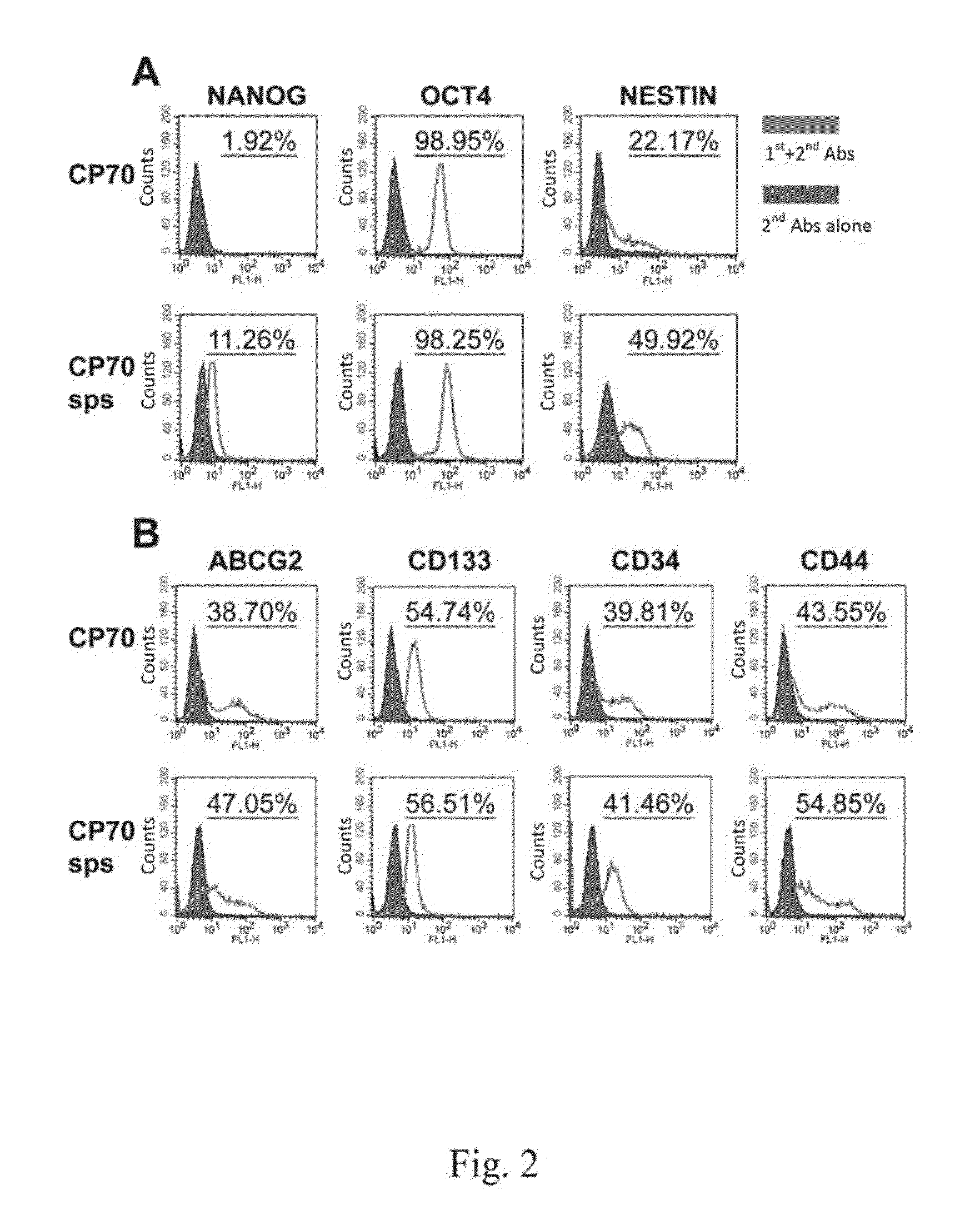Compounds used for treating cancer and the use thereof
a technology of compounds and cancer cells, applied in the field of cancer stem cells and cancer treatment, can solve the problems of limited success, difficult detection of ovarian cancer, and inability to effectively treat cancer,
- Summary
- Abstract
- Description
- Claims
- Application Information
AI Technical Summary
Benefits of technology
Problems solved by technology
Method used
Image
Examples
example 1
1. Experimental Materials
[0050]The ovarian cancer cells (CP70) and ovarian stem cancer cells (CP70 sps) are used, and CP70 cells were stained by Hoechst dye 33342 for screening of the side population cancer cells. The selected cells were then cultured in cancer stem cell culture media to induce differentiation and resulted cells are ovarian cancer stem cell, CP70 sps. To further verify the obtained ovarian cancer stem cells, various cell markers were stained, including NANOG, OCT4, NESTIN (an embryonic stem cell marker), ABCG2, CD34, CD44, CD133 and ALDH1. The results indicated that all markers showed increased expression (FIGS. 1A, 1B, 1C, 2A, and 2B). Additionally, the ovarian cancer stem cells (CP70 sps) formed spheroid (FIG. 1D).
[0051]Confirmation of the Stem Cell Differentiation Properties of the Ovarian Cancer Stem Cells CP70 sps
[0052]CP70 sps P0 cells were injected intraperitoneally (i.p.) into NOD / SCID mice. After 70 days, tumor nodules were harvested as CP70spsP1 cells. For...
example 2
Differentiation of MCF-7 Cells into MCF-7sps Cells and Inhibition Effect of Niclosamide
[0057]Hoechst dye 33342 was used for screening of side population cancer cells from MCF-7 cells followed by formation of MCF-7 sps cells in cancer stem cell culture medium from the selected cells. To further confirm the characteristics of the cultured MCF-7 sps cells, the cells were examined by various cell surface markers, including embryonic stem cell markers, NANOG, OCT4 and NESTIN, as well as cancer stem cell markers such as ABCG2, CD24 and CD44, which all showed increased expression (as shown in FIGS. 3A, 3B and 3C) and the Cp70 sps cells formed spheroid as indicated in FIG. 3D.
[0058]MCF-7 cells and MCF-7 sps cells were then compared by subcutaneous injection of these two cell lines into NOD / SCID mice, and the differences observed during the experimental period was recorded. The NOD / SCID mice with tumor formation were sacrificed and the size, weight and shape of the tumor formed were recorded...
example 3
The Inhibition Effects of Niclosamide on CP70 Cells and CP70 sps Cells
[0065]Around 1200 compounds that can potentially inhibit differentiation and growth of OVCA as well as OVCA sps cells were selected from the LOPAC database and tested for their toxicity effects by MTS assay and cell survival by ATP-based assay. Table 3 shows the inhibition results of the screened compounds on OVCA sps cells.
TABLE 3Compounds that can inhibit proliferationand differentiation of OVCA cellsCompoundCancer cell survival (%)Sanguinarine chloride20.37Ouabain26.69Diphenyleneiodonium chloride31.37Protoporphyrin IX disodium34.75Niclosamide34.86Rottlerin38.89(S)-(+)-Camptothecin39.11Brefeldin A from Penicillium brefeldianum41.18Calcimycin42.70(+)-Butaclamol hydrochloride42.81Dihydroouabain45.97Emetine dihydrochloride hydrate49.13Dequalinium dichloride54.68Vinblastine sulfate salt64.6
[0066]A total of 60 compounds that can potentially inhibit differentiation and growth of cancer stem cells were selected from th...
PUM
| Property | Measurement | Unit |
|---|---|---|
| plasticity | aaaaa | aaaaa |
| cell morphology | aaaaa | aaaaa |
| fluorescent staining | aaaaa | aaaaa |
Abstract
Description
Claims
Application Information
 Login to View More
Login to View More - R&D
- Intellectual Property
- Life Sciences
- Materials
- Tech Scout
- Unparalleled Data Quality
- Higher Quality Content
- 60% Fewer Hallucinations
Browse by: Latest US Patents, China's latest patents, Technical Efficacy Thesaurus, Application Domain, Technology Topic, Popular Technical Reports.
© 2025 PatSnap. All rights reserved.Legal|Privacy policy|Modern Slavery Act Transparency Statement|Sitemap|About US| Contact US: help@patsnap.com



